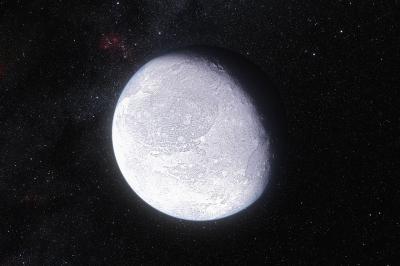
On 30 Aug 2006 the Hubble Space Telescope and the Keck Observatory took images of Dysnomia's movement
Taking advantage of a rare astronomical event called an “occultation” – when an object in the foreground blocks another object from view – scientists found that the dwarf planet Eris is not larger than Pluto, as previously thought, but is essentially the same size.
According to astronomers, occultations provide the most accurate, and often the only, way to measure the shape and size of a distant Solar System body.
Discovered in 2005, Eris is the most massive known dwarf planet in the Solar System. It is orbited by one moon, Dysnomia, and is about three times further from the sun than Pluto.
As a result, Eris and its moon are believed to be among the most distant natural objects in our Solar System.

An artist's impression of the dwarf planet Eris. (Photo: Credit: ESO/L. Calçada)
The discovery of Eris led scientists to create a new class of objects called dwarf planets. That started a chain of events which eventually led to Pluto’s demotion from full-fledged planet to its current classification as a dwarf planet.
An international team of astronomers got the occultation they needed to observe Eris in November 2010. Using a number of observational tools, including the TRAPPIST (TRAnsiting Planets and PlanetesImals Small Telescope) at the La Silla Observatory in Chile, the team discovered that Eris is almost spherical in shape. They also determined Eris’ diameter to be 2,326 kilometers. Previous measurements put the dwarf planet’s diameter at around 3,000 kilometers, or approximately 25 percent larger than Pluto.
These new findings also suggest that the surface temperature for the side of Eris facing the sun is about -238 Celsius at most, with even colder temperatures on its night side. Its surface is extremely reflective, reflecting 96 percent of the light that falls on it, making it to be one of the most reflective objects in the Solar System.





















You know, there are numerous article on the “Science World” blog I borward along links to others, using the rather cumbersome method of forwarding links out of my browser’s menu. It would be nice to see a mail link added to the Twitter and Facebook links, since I do not use either of those social plague services.
Hi James – Thanks for checking us out. I can understand how frustrating it could be to do things the hard way when there are tools out there that make things easier. I like your suggestions and will confab with our amazing IT team here and see if we can add those items to our page. Great idea!
Rick Pantaleo